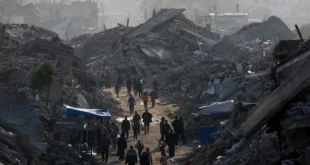The Islamic State terror group has set conditions for a comeback that “could be faster and even more devastating” than when it first burst onto the world stage, according to a new report out Wednesday.
ISIS’s Second Comeback: Assessing the Next ISIS Insurgency, by the Washington-based Institute for the Study of War (ISW), also warns the terror group, often referred to as IS or ISIS, is likely to reclaim territory both in Syria and in Iraq, where it is already seizing control.
“ISIS has systematically eliminated village leaders and civilians who cooperated with anti-ISIS forces,” the report says. “It has re-imposed taxes on local populations in its historical support zones, displacing civilians and de facto controlling small pockets of terrain in Iraq.”
In Syria, IS faces a more daunting task, where it is still battling the U.S.-backed Syrian Democratic Forces, forces loyal to Syrian President Bashar al Assad, and Hay’at Tharir al-Sham, al Qaida’s Syrian affiliate.
Still, the report’s authors believe IS is well-prepared for the fight, having taken advantage of the slow and methodical U.S.-backed campaign to roll back the terror group’s self-declared caliphate.
“ISIS deliberately withdrew and relocated many of its fighters and their families,” the reports states.
“ISIS’s forces are now dispersed across both countries and are waging a capable insurgency,” it says. “ISIS retained a global finance network that funded its transition back to an insurgency and managed to preserve sufficient weapons and other supplies in tunnel systems and other support zones in order to equip its regenerated insurgent force.”
The concerns about a possible IS resurgence are not new.
As far back as August 2018, U.S. defense officials were warning IS was “well-positioned to rebuild and work on enabling its physical caliphate to re-emerge.”
More recently, U.S. Assistant Secretary of State for Stabilization Denise Natali warned, “the threat persists.”
And even this week, a statement by the Global Coalition to Defeat IS, admitted the terror group remains both resilient and undaunted, with cells in Syria and Iraq to conduct an increasing number of attacks against coalition partners and coalition partner forces.
“This is a major concern for the entire Coalition, as it puts at risk key military gains and the stability necessary for recovery,” the statement said.
Data compiled by the Syrian-based Rojava Information Center and published earlier this month seems to support such concerns.
The center found there were 139 attacks by IS sleeper cells in northeastern Syria alone in May, an increase of 61% over the previous month. The number of deaths also rose, 42% in May to 78, with increases even in previously secure areas.
In addition to the attacks, IS has been blamed for burning hundreds of hectares of farmland in Syria and Iraq.
According to the most recent U.S. estimates, IS still commands at least 10,000 fighters across the two countries. But despite the threat, U.S. troops involved in supporting the fight against IS have been leaving Syria.
“The number of U.S. forces that are present now is quite a bit lower than when the drawdown began,” Chris Maier, the director of the Pentagon’s Defeat IS Task Force, told a small group of reporters last month.
“U.S. force numbers will continue to draw down as conditions continue to, we hope, improve,” he added.
Since then, some U.S. forces have been assigned to return to Syria, but according to U.S. defense officials, their primary mission is to protect forces there from growing threats from Iranian proxies in the region.
The overall trendlines, though, concern the authors of the ISW report, calling the lessening U.S. engagement, especially in Syria, “a critical mistake.”
Instead, the report calls on the U.S. to develop a long-term strategy that combines both military and a plan to address ongoing economic and humanitarian problems.
“Another limited intervention will not be sufficient,” concludes study co-author Jennifer Cafarella.
“The ISIS campaign in Iraq and Syria has demonstrated to ostensibly liberated communities that they are not safe, perpetuating conditions of fear and distrust that will make it increasingly difficult to establish durable and legitimate security and political structures.”
 Eurasia Press & News
Eurasia Press & News



